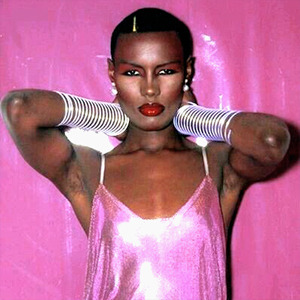Text
Rating Black Vampires
For me Blacula gets a 9/10. Personally I think he’s a very captivating character, and his backstory makes him all the more original and interesting. I like how far removed his character is from whiteness, which is refreshing because vampires almost always seem entirely focused on white narrative and/or provoked by ideas of white beauty. Blacula takes an attractive Black man and places him within the role of an attractive Black vampire. I give him a 9/10 because I feel that his story is slightly lacking. It’s crazy to start something off as crazy as Dracula being a racist slave owning prick and then… not do anything with that? I also feel that Blacula’s costume design could have been just a bit more inspired by his cultural heritage. However, the romantic plot was amazing and was honestly a core part of this film for me. Love knows no boundaries! Not even time.
Greedy Choke Puppy is a story about a Caribbean vampire called a soucouyant, and a young woman who finds out she is one after she peels off her skin and flees into the night as a fiery being. I give this story a 10/10, because it was genuinely interesting and I learned something new. I love how in the story, being a soucouyant is passed down from generation to generation, and how it ended up being the main character’s grandmother who thwarted her (as well as her mother, as we later come to find out). I give this a 10/10 because it’s very different from the typical vampire one might think of, and I valued its cultural roots! Definitely a staple of Black horror. I think this story deserves a lot more recognition than it gets, because it’s genuinely well-written, and a great exploration of cultural folklore.
Vampire in Brooklyn gets a 10/10 (I’m sorry Black vampires kind of just do it for me). The story is awesome, Eddie Murphy plays a GREAT vampire, and I love how reminiscent of Blacula this film is. However, I do appreciate the different take with Eddie Murphy’s character Maximillian being actually evil and exploitative. Definitely a breath of fresh air from the typical good-guy narrative. I mean, Blacula isn’t necessarily a good guy, but he is complicated. Also, Eddie Murphy as a vampire is just *chefs kiss*, he played this role like he had to make rent.
6 notes
·
View notes
Text
Black Horror and Portrayal of Occult
Black horror has consistently been entranced with magic and mysticism, portraying African cultural aesthetics such as Vodou and ancestor worship. Many Black horror movies include themes of possession, occult, and ritualism which are portrayed differently from other horror because of a unique and stigmatized cultural lens.

Eve’s Bayou is interesting in its portrayal of Vodou and mysticism, as supernatural aspects of Black Southern life seem to be normalized. There are a range of different powers at play within the film, such as with Aunt Mozelle who is simultaneously blessed with foresight and plagued by a curse that has killed all her past lovers in varying gruesome fashion. The film’s main character, Eve, is also clairvoyant herself, and recruits the help of a Vodou lady in order to kill her promiscuous father. Eve is played by Jurnee Smollet, who also happens to star in Lovecraft Country, another show which centers itself around the occult.
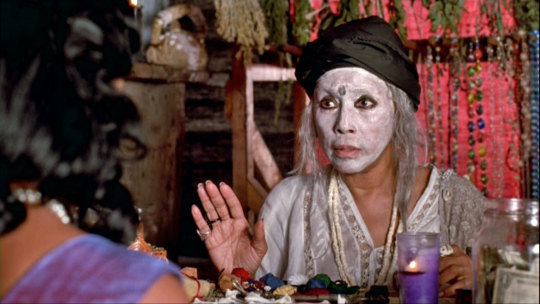
Magic and mysticism is also very present in Blaxploitation horror, such as Scream Blacula Scream with its revival of Blacula via Vodou, or Sugar Hill, which makes use of the Vodou zombie trope through a thrilling tale of revenge. You also have the film, Abby, a horror film in which a woman is possessed by the Yoruba sex spirit, Eshu. Blaxploitation horror also includes portrayals of Black vampires and ghosts, heavy with themes of retribution, racism, and other social issues. These Blaxploitation films, while not really the best portrayal of African occult practices, are unique from other horror in that the horror is specifically of Black origin, again, an example of how Black horror looks at magic and mysticism through a cultural lens. This is in contrast to Western horror flicks, which seem to revolve around the general white sphere and look at magic and mysticism through a strictly gimmicky lens (vampires not as cultural figures, but as marketable boogeymen).

Themes of magic and mysticism can also be found in films such as Get Out, Candyman (both the originals and the sequel), and His House. Get Out’s usage of the mysticism is much more subtle than the rest, but it can be found in the beginning with the usage of the song, Sikiliza Kwa Wahenga, a Swahili song which Jordan Peele states is mean to represent Chris’s ancestors warning him to “get out”. Candyman’s usage is a bit more obvious, with magic and mysticism represented through the oral passage of Candyman as urban legend, which is explored in the 2021 sequel as a simultaneous representation of oral traditions of old, as well as generational trauma from racialized killings of Black men. Lastly, His House makes use of the apeth, otherwise known as a Night Witch in Dinka culture, a creature by which they must repay a debt to after abducting a child and getting said child killed.

#his house#get out#black horror films#horror movies#horror films#lovecraft country#candyman#sugar hill#eves bayou#blacula#blaxploitation#abby
490 notes
·
View notes
Text
Candyman and Blackness as Horror
Candyman is an interesting franchise/character which balances on the boundaries between Black Horror and fear of Blackness. While at the time it may have been nice to see oneself represented in the horror franchise, as black people (like with all media) were very heavily underrepresented at the time, the film still plays on harmful ideas of blackness in order to scare its viewer. For example, the set design is a great issue. The neighborhood of Cabrini-Green, already dilapidated by itself, was literally dressed up to appear “hooder”, to appear scarier and “blacker”. The set evokes the viewership of a scared white audience, who has come to associate aesthetics of poorness such as graffiti and such with Black people.

There’s also the issue of Candyman himself, or black men as a whole. In the film, Black men are portrayed as large and violent. You have “Candyman” the gang leader, who assaults Helen in a bathroom for no real reason other than to assault a woman. This alone puts forth ideas of danger in Black neighborhoods, that an innocent white woman could waltz in and get herself beaten up for no reason. Moving on to Candyman, this character’s villainy is heavily racialized as he is the ghost of a lynched Black man… chasing after a white woman (and killing Black people in his wake.)

Candyman’s character is harmful because he is reminiscent of stereotypes which prevail after Black men, which is their rampant lust for white women and their willingness to do anything to get them. Think about the character “Gus” (a white man in black face) from Birth of a Nation, who literally chases a white woman off of a cliff in his quest to rape her. The usage of Helen in this film is literally to frame that horror of Candyman as a racialized fear of Black men.
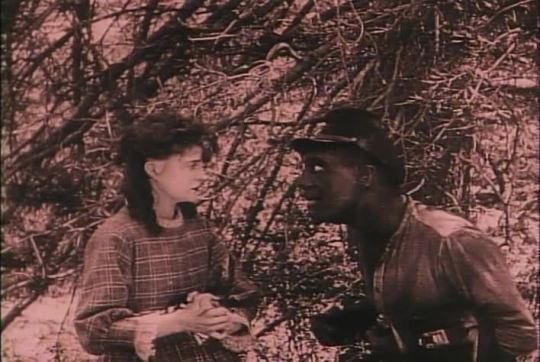
Lastly, Helen’s role as the white savior is what moves the film forward. Not only does she wander into a random Black neighborhood trying to dispel a legend to which she has no business even treading around, but she just happens to be the savior of them all when it’s revealed that she may or may not be the reincarnation of Candyman’s white lover. This is not even to mention the film’s usage of lighting with Helen as opposed to Cabrini-Green and its residents. Helen is portrayed as the innocent angelic white woman, her face lit up unnaturally as if she were in a dream, while the neighborhood and its residents are shrouded in darkness and dirt.
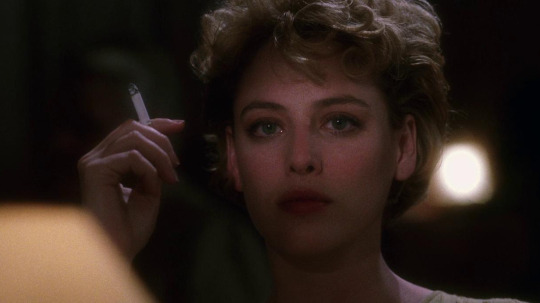
9 notes
·
View notes
Text
Nope and the Making of the Spectacle
In this short post, I hope to break down the making of spectacle in the film, Nope (2022).
The film, first off, is a subversion of the Western genre. It operates on an aspect ratio ranging from 1.33:1 to 2.20:1, following the traditional widescreen model of the Western which values the spectacle of landscape, the Wild Wild West. The film relies on the widescreen to showcase key horror elements, emphasizing vastness, emptiness, and a fear of something bigger than you.

Also important to note is how the film uses darkness to make said landscape more intimidating, which plays on the fear of smallness as opposed to largeness of environment.

This brings me to the topic of eldritch horror, a horror subgenre which Peele explores with Jean Jacket. Eldritch horror is plainly defined as a fear of the uncanny, though, can be expanded to include the fear of the uncanny and one’s realization that they are meaningless in comparison. Jean Jacket, a being which poses itself against all known laws of worldliness, can be described as an eldritch abomination; a spectacle to behold. Commonly with the eldritch abomination, simply looking at it spells death or madness for the witness, which we see in Nope as looking at Jean Jacket (beholding it) means death.

However, something that was interesting is that Peele denotes Jean Jacket to an animal by using animal logic to defeat it. See, Jean Jacket definitely is an iteration of the eldritch abomination, but the plot twist is that Jean Jacket’s existence is much more grounded. This ties in to the overarching theme of the film, which is the reaction of the animal when it has been turned into a spectacle. The film starts off with this quote:
“And I will cast abominable filth upon thee, and make thee vile, and will set thee as a spectacle"
This quote sets up the arcs of both Gordy and Jean Jacket, both in parallel to one another as to what happens when humanity errs too close to the boundaries of control. Gordy, a full grown chimpanzee who is personified/humanized for entertainment, kills the cast of Gordy’s Home as a result of being made into a spectacle (and is thus killed for responding like any animal would to a sudden noise). Jean Jacket refuses to be exploited, and instead eats those who behold it.
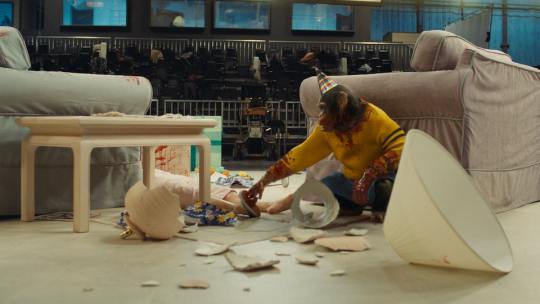
This opens up another point of discussion as to how animals in the entertainment industry are exploited for the simple spectacle of being tamed or “friendly”, thus we have instances like with OJ’s horse “Lucky” wherein the animal’s comfortability is disregarded for the simple fact that it is viewed as a prop.
#nope film#nope 2022#tananarive due#gordy nope#jean jacket#nope spoilers#black horror films#black film#jordan peele
132 notes
·
View notes
Text
Symbolism in Get Out
In Get Out (2017) we find a multitude of symbols which allude to historical references within ideas of slavery, the Old South, and Jim Crow. First off, we see a parallel drawn between Chris and the buck. Historically, Black men were labeled as “bucks” which was a stereotype assigned to “aggressive” Black men who refused to bend to white society. We see this idea of “aggression” assigned to Chris by Jeremy, who takes an interest in his “physique” and thus must challenge him in the art of strength. I think the relationship between these two characters is interesting because Jeremy, in categorizing Chris as a “buck” underestimates his true ability to outsmart him.

As we see with the bingo scene, Chris is quite literally put on auction, with party-goers feeling him up and demeaning him with micro-aggressions such as “Black is in”, and “Is it true? Is it better?”. The film uses these types of microaggressions and expands them into a scope under which we may view them as horrific, putting casual and covert racism under a lens by which we would be more likely to feel on edge. With that in mind, I like to say that Get Out is an inside joke within the Black community, as we already fear and analyze these types of interactions. It is white audiences that might turn a blind eye to them, and white audiences who would be coming to these revelations of horror.
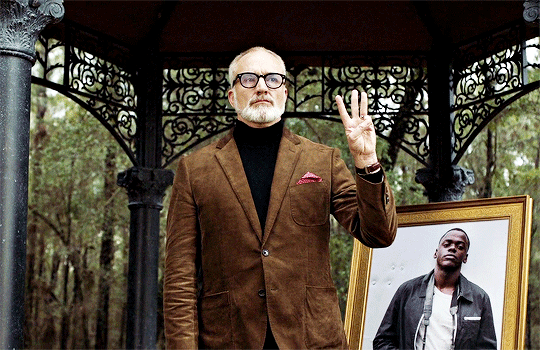
Furthermore, on the topic of “turning a blind eye” we arrive upon ideas of “colorblindness” with the blind art dealer. The art dealer, despite participating in a racist system, absolves all responsibility from himself as he is literally colorblind. It is reminiscent of real instances of gaslighting wherein the concept of “colorblindness” somehow absolves an individual of all aggressions, privilege, and intention.

In the beginning and end of the film, the song “Sikiliza Kwa Wahenga” plays. The song plays into the entire plot of the film, playing as an ancestral warning for Chris to “get out”.
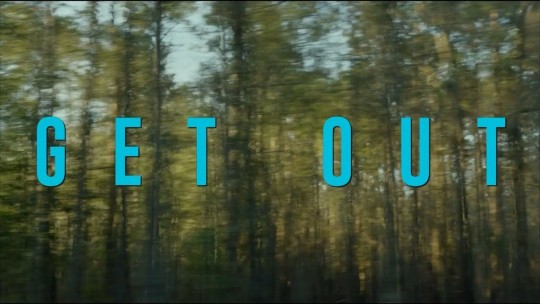
You have ideas of slavery represented in Chris’s escape scene, as he scratches the leather chair and plucks out cotton to block out hypnosis. This action, while having saved his life in the long run, is reminiscent of the literal action of picking cotton.
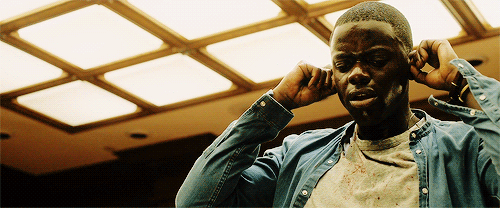
On the topic of slavery, the sunken place itself is a form of psychological enslavement wherein the white parasite uses the Black body for their own enjoyment and benefit, while the Black host is forced to watch as their body is abused, raped, and taken away from them.
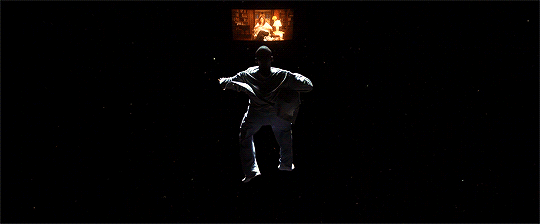
#get out#get out 2017#horror#black horror#horror films#black horror films#tananarive due#afrofuturism
131 notes
·
View notes
Text
Nichelle Nichols’s impact can not be overstated.
She was the first black woman to go to space on tv (and her impact on representation on TV should also not be understated) but she also campaigned for NASA applications of diverse voices. Her campaign led to the recruitment of Sally Ride (first American woman in space), col. Guion Bluford (first black astronaut in NASA), and Mae Jeminson (first black woman in space).
Without her personal recruitment campaign (which she threatened to sue NASA if she put her reputation on the line to bring in these applications if they then did not go on to hire any of them) who knows how much longer it would have taken to get anyone other than a white man as a NASA astronaut.
28K notes
·
View notes
Text

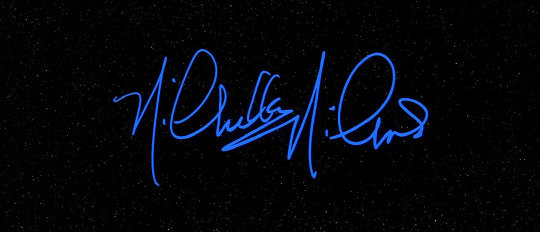
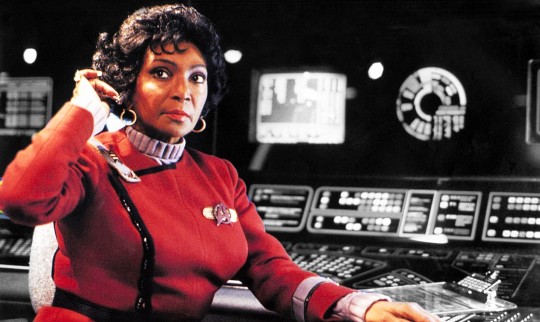


To the woman that inspired countless girls and people of color, we will never forget you.
You will always be in our hearts.
Thank you for going where no woman had gone before.
Nichelle Nichols 1932- 2022
25K notes
·
View notes
Text
Black Mysticism
Hi guys, if you haven't read "Greedy Choke Puppy", I suggest you do. It's a great read about these Black vampires called "soucouyants" which are basically creatures (usually old women) from Caribbean myth that shed their skin and shift into a ball of fire. They then fly around, looking for children to suck the life from.
Anyway, this leads me to a future project I have been toying with. Now, I am currently transitioning from my freshman year of college into my sophomore year, having just entered into the very last week of Spring Quarter. During this quarter, I took Tananarive Due's class "Aboard Mothership: Intro to Afrofuturism", but I am looking forward to another class she will be teaching in Fall quarter on Black Horror.
Now okay, done with all that background stuff. I had this idea for a Black horror piece based on the existence of Caribbean sirens, who are said to kidnap people from the coast. In fact, many people have actual stories of themselves being taken by mysterious women of the sea. You also have the existence of Mami Wata, a Vodou spirit who is said to have aided enslaved Africans throughout the voyage across the Atlantic.
I wanted to center my story around a siren who, similar to a soucouyant, sheds her skin and is mistaken as human and transported across the Atlantic, but then regains her form when she is thrown overboard. The course of the story would follow her getting vengeance for her kidnapping, helping the enslaved African onboard to stage a mutiny. However, I also had this idea of others being thrown overboard with her and dying, only to then become Mami Wata spirits along with the main character. I think a huge horror element would be body horror, with the main character having to reform a new skin after losing access to her other one.
I don't completely have it all mapped out yet, but that's what I'm thinking for the future. I still have to do research on the myth, though resources are scarce. I remember this one illustration I saw on here of the same myth, but I can't quite remember who posted it or how to access it. I remember it was a comic of some kind? Where a woman kidnaps a man who attempts to harass her, revealing herself to be a siren. Anyway, those are just my thoughts.
0 notes
Text
The Brother From Another Planet, and the Issue of Black Pain
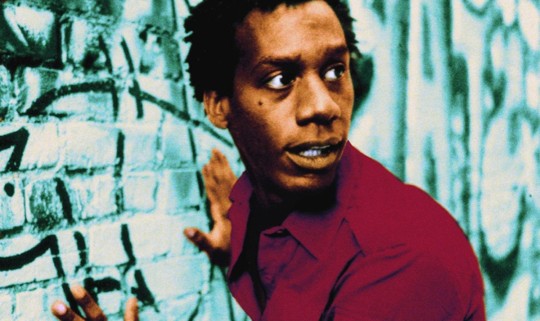
In lecture, we talk about a film called The Brother From Another Planet (1984) a sci-fi film directed by John Sayles, a well-meaning but unfortunately white director. Why bring that up you ask? Because The Brother From Another Planet, despite being a sci-fi film and having the liberty to tell any other type of story, pictures The Brother (main character) as a Black alien escaping from outer-space slavery.
Black pain has come up a lot in media talks about Black people’s portrayals in film. We are consistently portrayed as slaves, gangsters, fiends, or victims of a system. While these things have truth to them, one has to wonder why Black people rarely ever get their own unique storylines like the (white) characters of Game of Thrones and Interstellar. Why is Hollywood so intent on this single-edged portrayal of Black people in relation to racial prejudice or impoverishment?
The Brother From Another Planet takes the sci-fi genre, establishes the existence of life on other planets, and yet still portrays its Black main character as a runaway slave. Professor Due said it herself during lecture, that it is so disheartening that even on other planets, Black people are still not free. Any other (white) character would have maybe been fleeing some type of bureaucratic alien government, or a hero sent down to Earth to save humanity. But The Brother is merely a slave, and worse, an alien made to assimilate.
Even in current sci-fi, like Lovecraft Country, many of its central conflicts revolve around racial violence. Case in point being one of the first episodes, where the main characters literally escape a Sundown Town? No one is saying to avoid the conflict of prejudice all-together, but why are Black people consistently limited to these tropes? Why can’t we have more stories of heroic Black starship captains, or stories of Black superheroes without the tired trope of “driving while Black”?
I would also like to mention that these tropes of Black pain are not even used for education most of the time. In fact, some of these portrayals are down-right fetishized, (I’m looking at you, Them) where Black pain is literally played to shock an audience or for gore-porn. Detroit has this issue. It is a movie entirely revolved around the torture of young Black boys, supposedly a true story, but with some of it also being pure fiction? Why add your own spin on such a horrifying story about something that happened to real people? I’m not even gonna touch on the director being a white woman.
But anyway, that’s my rant.
#the brother from another planet#tananarive due#afrofuturism#sci fi#black pain#black horror#lovecraft country
124 notes
·
View notes
Text
Clones and the Loss of Soul
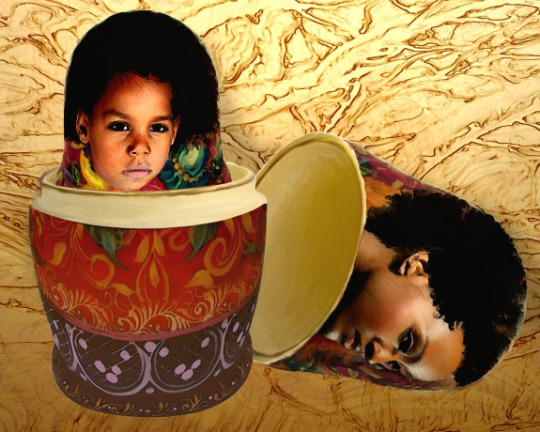
In Black culture, Soul is widely prevalent within everything we do. Soul is in our food, our dances, our voices; it is in the rhythm at which we snap our fingers and the atmosphere of outdoor cookouts. So what happens when something that is supposedly us lacks soul?
Using Us (2019) and Like Daughter by Tananarive Due, I would like to analyze the loss of, or absence of soul as it relates to trauma and cloning.
Now, if you don’t know the lore of Us, the clones, or “tethered” as they’re called in the film, lack souls. Red tells us that the people who made them, tried to control the above ground people so that they could control them, but what went wrong was that they couldn’t recreate souls. Thus, the tethered became the controlled, lacking any soul or free will. In fact, it was only Red’s possession of a soul that allowed her and the tethered to rise up and rebel against the overworld.
In Like Daughter, it is kind of the same thing, except clones were created as baby mimics for people wanting to revive dead loved ones and the such. The character, Denise, clones herself to give herself the childhood she lost to abuse and neglect.
However, I would like to pose the state of being without a soul as a metaphor for the trauma each individual character experienced. Adelaide, Red’s above ground counterpart who switched places with her as a child, lacks a soul because she is truly a tethered. But I theorize that her lack of a soul represents trauma caused by spending her childhood underground (and quite possibly more aware than the other tethered if she was able to switch places.) Red has a soul. Her character trait is that she is always on beat, whether it be to her own rhythm or the movie’s actual soundtrack; and yet, she also loses her soul to the horrors she experienced.
In Like Daughter, Paige describes Denise as “a vagrant in her own home” when she sees her for the first time in the story. With more context, we find that Denise had completely fabricated her entire family life to give the clone version of herself the childhood she always wanted. Her husband is not her lover, and is only there to complete the image, and when the image shatters, all that is left of Denise is a husk. Denise essentially sculpts a soulless marriage for a soulless child. In this way, I would argue that Denise’s inability to bring soul to her life is caused by her absolute lack of one, her loss of one to her horrific childhood.
As Al Pacino’s character states in the film, Scent of a Woman (1992), “...there is nothin’ like the sight of an amputated spirit. There is no prosthetic for that.”
1 note
·
View note
Text
Wastelands, and My Search for Afrofuturism
For my Afrofuturism class, I was assigned the task to complete a film, essay, or a short story. While I went with a film at first, I ended up deciding on a story due to some... unforeseen circumstances. However, while searching myself for a story after such an abrupt change of plans, I found myself questioning the meaning of Afrofuturism. Is it simply Black people IN the future? How does a sci-fi universe with a single Black character count as Afrofuturism? We discussed in class that Afrofuturism is simply a setting with a Black protagonist possessing agency, and yet, this definition feels too broad. During my short story, I dealt with this constant question of “Am I writing Afrofuturism? Or am I just Writing fantasy?”
Anyway, on the topic of my story, I wrote a short narrative called Wastelands, which is set in a sprawling pink desert that buried ancient human civilization. My main character is Amon, an “Anmarist” monk who goes on a trek through the desert as part of a rites of passage, but encounters prejudice, poverty, and wavering belief along the way. I wanted to explore what I felt was severely underappreciated in Afrofuturism, which is East African and Arab culture. While yes, I understand it’s Afrofuturism, I too often feel like cultural interaction with Africa from other cultures is a neglected theme, especially when one considers trade, cultural exchanges in ancient times, and the very conjoined worlds of Africa and the Middle East during the Medieval period.
The story also came about from my own exploration of religion. In Wastelands, the story follows Amon, who is ethnically/religiously Anmarist, leaving the temple and having to come to terms with the oppression of Anmar people as a religious and ethnic minority. Anmarists, throughout the story, are consistently subjected to prejudice, whether it be blatant religious oppression in the case of Femi (a character we meet later, and who is implied to be Amon’s sister), or contract slavery due to the impoverished state of most Anmar families. Furthermore, many Anmarists have all but abandoned their religion and traditions (like wearing a veil over the face) to avoid prejudice.
The story apparently turned out pretty good from what my partner says, but I personally just had my own battles with it. Maybe it’s a symptom of writing and doing art and stuff? Like, just always hating your work? I don’t know.
0 notes
Photo


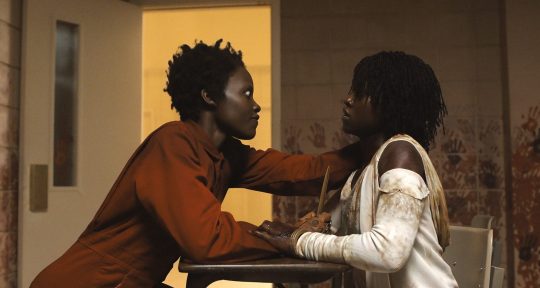


Red in Black Cinema
Do the Right thing (1989)
BlacKkKlansman (2018)
Us (2019)
Malcom X (1992)
Sorry to Bother You (2018)
#do the right thing#blackkklansman#us#us 2019#malcom#spike lee#sorry to bother you#jordan peele#boots riley#black film
486 notes
·
View notes
Text
Earthseed Community
In Octavia E. Butler’s novel, Parable of the Sower, the Earthseed community is a group escaping climate change, anarchy, corruption, and a dying earth.
With these things in mind and considering the current state of the world, my Earthseed community would be escaping among the same things (minus the total anarchy which we see in the book). We’d be seeking shelter from a similarly ailing earth, and government(s) that inflict racial, gender, sexual, and environmental damage on both their people and the land they stand on.
In order to rise From its own ashes, A phoenix first must burn.
-This verse is one that my community will take to heart, as many of the ideals and principles that have been instilled within us by society would have to be vanquished to truly create change. In order to rise from its own ashes, my Earthseed community will have to burn away all that has previously plagued society and festered within it for so long, including -isms and selfishness.
As wind, As water, As fire, As life, God Is both creative and destructive, Demanding and yielding, Sculptor and clay, God is Infinite Potential: God is Change.
-This verse challenges society’s rigidness, and will be implemented within my community as a lesson on adaptation. Humans tend to think that they can control nature; they tend to think that they are God and that they are change. With this verse in mind, my community will learn that change is inevitable and that one can never confront it as a mere man.
____
I like the idea in the book of escaping to another planet, so I think my community would do something similar. The idea would be to live on a giant, self-sustaining ship, cruising between worlds and discovering new things and peoples. Anyone who is willing to work alongside others and forgo greed/selfishness would be welcome, as I’d like to kind of form an anarchist-type community where means of production would not be for profit-- but for collective growth. The leadership of my community would be composed of councils and representatives, with each community member getting an equal vote in matters of communal importance and discussion. On the ship, I’d utilize futuristic bio-mimicry technology to produce things such as water and encourage agriculture/gardening. With this in mind, my ship would be self-sustainable due to this technology, as well as vertical farming and research/exploration of other planets.
My Earthseed community will provide reasonable, costless housing for all of its members based on their needs, research and preserve animal populations that we have managed to save from our dying Earth, and provide accurate and unbiased education to children and adults alike.
3 notes
·
View notes
Text
Afrofuturism and Suppression of Dreams
The 2009 film, Pumzi is an African-futurist film which deals with issues such as environmental collapse, and importantly for this post, the suppression of dreams in favor of technological advancement. The way I see it, suppression of dreams can be equally associated with suppression of culture. Many African cultures (with Vodou spirituality being my most knowledgeable field) interpret dreams for prophecy, religious callings, and communication with higher beings. With this being said, and keeping in mind that Pumzi (2009) is specifically an African-futurist narrative, one comes to the conclusion that suppression of dreams represents a separation from faith, the environment, and one another. Considering the desolate landscape in which the film takes place, in which technological progression is the only way for humanity to stay afloat; it also symbolizes a pessimistic view on the future wherein there is no actual hope that things will get better, or that “dreams come true.” The world of Pumzi (2009) has almost successfully eradicated hope; but in the end, hope is what will save the environment and humanity from itself.
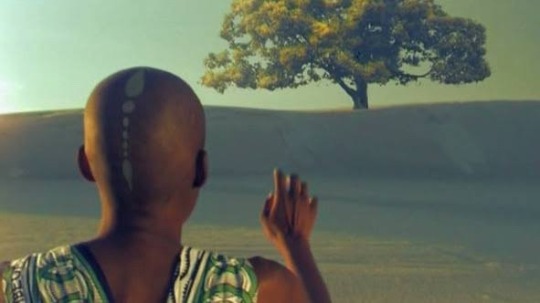

3 notes
·
View notes







